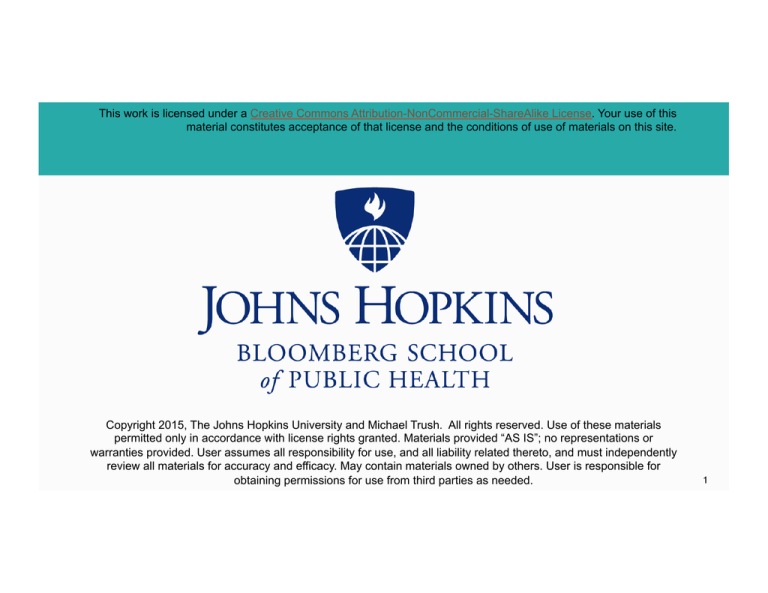
This work is licensed under a Creative Commons Attribution-NonCommercial-ShareAlike License. Your use of this
material constitutes acceptance of that license and the conditions of use of materials on this site.
Copyright 2015, The Johns Hopkins University and Michael Trush. All rights reserved. Use of these materials
permitted only in accordance with license rights granted. Materials provided “AS IS”; no representations or
warranties provided. User assumes all responsibility for use, and all liability related thereto, and must independently
review all materials for accuracy and efficacy. May contain materials owned by others. User is responsible for
obtaining permissions for use from third parties as needed.
1
Reproductive and Developmental Toxicology
James D. Yager, PhD
Johns Hopkins University
Section A
General Principles of Reproductive Toxicology
The material in this video is subject to the copyright of the owners of the material and is being provided for educational purposes under
rules of fair use for registered students in this course only. No additional copies of the copyrighted work may be made or distributed.
Lecture Outline
! Introduction and general principles
! Reproductive toxicology
! Developmental toxicology
! Case studies
! Thalidomide
! Endocrine disruption
• Diethylstilbestrol (DES)
• Bisphenol A (BPA)
• Testicular dysgenesis syndrome—phthalates and pesticides
4
Frequencies of Selected Reproductive Failures
Event
Frequency
per 100
Unit
Failure to conceive after one year
10–15
Couples
Spontaneous abortion 8–28 weeks
10–20
Pregnancies or women
Chromosome anomalies in spontaneous abortions, 8–28 weeks
30–40
Chromosome anomalies from amniocentesis, > 35 years
Stillbirths
Birth weights < 2,500 g
2
2–4
Amniocentesis specimen
Stillbirths, live births
7
Live births
Birth defects
2–3
Live births
Chromosome anomalies, live births
0.2
Live births
Severe mental retardation
0.4
Children to age 15
5
Reproductive Toxicology
! What is it?
! Study of the recurrence, causes, manifestations, and sequelae of adverse effects of
exogenous agents on reproduction
! Targets for chemical toxicity
! Reproductive toxicity endpoints
6
Drugs that Are Gonadotoxic in Humans
! Males
! Bisulfan
! Chlorambucil
! Cyclophosphamide
! Nitrogen mustard
! Adriamycin
! Corticosteriods
! Cystosine arabinoside
! Methotrexate
! Procarbazine
! Vincristine
! Vinblastine
! Females
! Bisulfan
! Chlorambucil
! Cyclophosphamide
! Nitrogen mustard
7
Environmental Chemical Exposure Associated with Reproductive Function
! Males
! Carbon disulfide
! Chlordecone (Kepone)
! Chloroprene
! Dibromochloropropane (DBCP)
! Ethylene dibromide
! Ethylene oxide
! Ethanol consumption
! Glycol ethers
! Hexane
! Inorganic lead (smelter emissions)
! Organic lead
! Pesticides (occupational exposure)
! Vinyl chloride
8
Environmental Chemical Exposure Associated with Reproductive Function
! Females
! Anesthetic gas (OR personnel)
! Aniline
! Benzene
! Carbon disulphide
! Chloroprene
! Ethanol consumption
! Ethylene oxide
! Glycol ethers
! Formaldehyde
! Inorganic lead (smelter emissions)
! Organic lead
! Methyl mercury
! ! ! ! ! ! ! Pesticides (occupational exposure)
Phthalic acid esters (PAEs)
Polychlorinated biphenyls (PCBs)
Styrene
Tobacco smoking
Toluene
Vinyl chloride
9
Neuroendocrine
10
Reproductive Tissue
! Sertoli cells (blood-testes barrier)
! Leydig cells (production of testosterone)
11
Reproductive
Tissue—Testis (4x)
This image can not be provided
due to copyright
12
Reproductive
Tissue—Testis
(40x)
This image can not be provided
due to copyright
13
Reproductive Tissue: Seminiferous Tubule of the Testes
This image can not be provided
due to copyright
14
Reproductive
Tissue:
Seminiferous
Tubule
15
Reproductive
Tissue: Target
Sites in
Spermatogenesis
Target
Toxicant
Leydig cell
Ethane dimethane sulfonate; ethanol
Sertoli cell
Phthalate esters; 1,3-dinitrobenzene; 2,5hexanedione
Spermatogonium
Busulfan; other antimitotic agents
Spermatocyte
Ethylene glycol; monomethyl ether
Spermatid
Ethyl methane sulfonate; methyl chloride
16
Reproductive
Tissue: Ovary and
Ovarian Follicles
! Mouse ovary, 4x
This image can not be provided
due to copyright
17
Reproductive
Tissue: Ovary and
Ovarian Follicles
This image can not be provided
due to copyright
18
Reproductive
Tissue, Ovary
This image can not be provided
due to copyright
19
Reproductive
Tissue
This image can not be provided
due to copyright
20
Reproductive Toxicity Endpoints
! Reproductive endpoints indicating reproductive dysfunction
! Decreased libido: impotence
! Sperm abnormalities: decreased number/motility: morphology
! Subfecundity
21
Reproductive Toxicity Endpoints
! Subfecundity
! Abnormal gonads/ducts of external
genitalia
! Abnormal pubertal development
! Infertility of male/female
! Amenorrhea
! Anovulatory cycles
! Delay in conception
! Illness during pregnancy/parturition:
toxemia—hemorrhage
! Early fetal loss (to 28 weeks)
! Late fetal loss (after 28 weeks)/
stillbirth
! Intrapartum death
22
Reproductive Toxicity Endpoints
! Death in first week
! Multiple births; birth defects
! Decreased birth weight
! Infant death
! Gestational age at delivery;
prematurity; postmaturity
! Childhood morbidity; childhood
malignancies
! Altered sex ratio; chromosome
abnormalities
23






